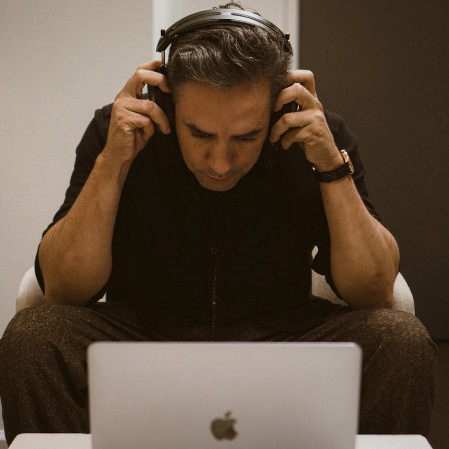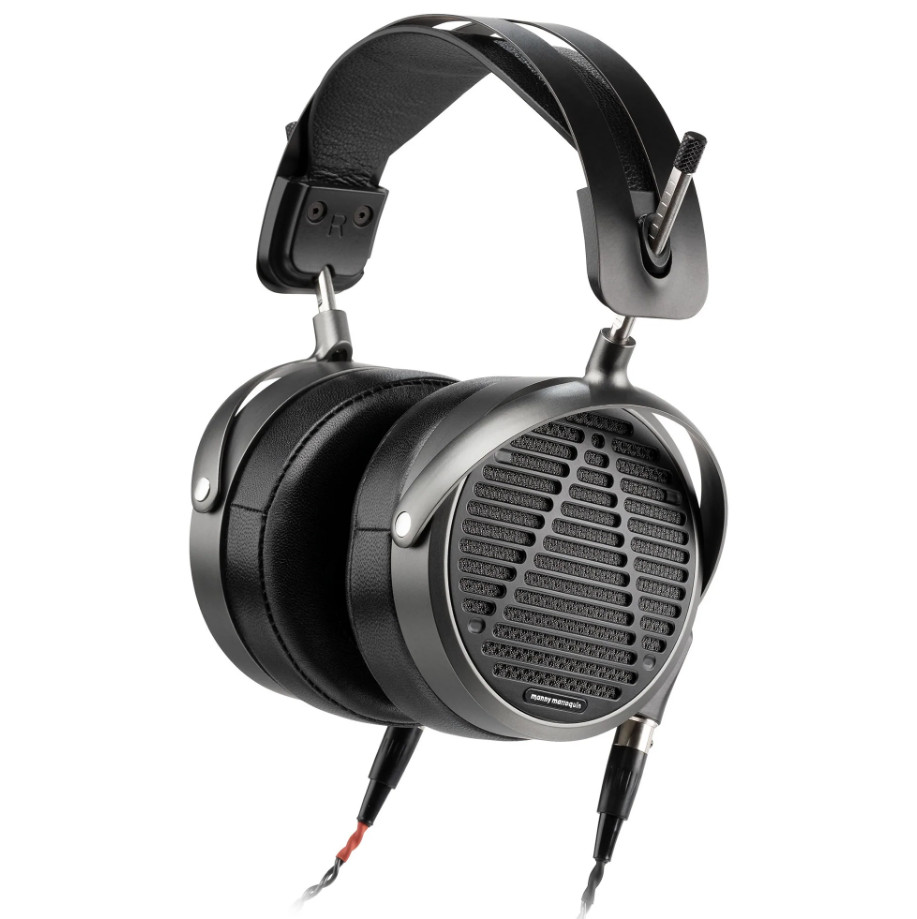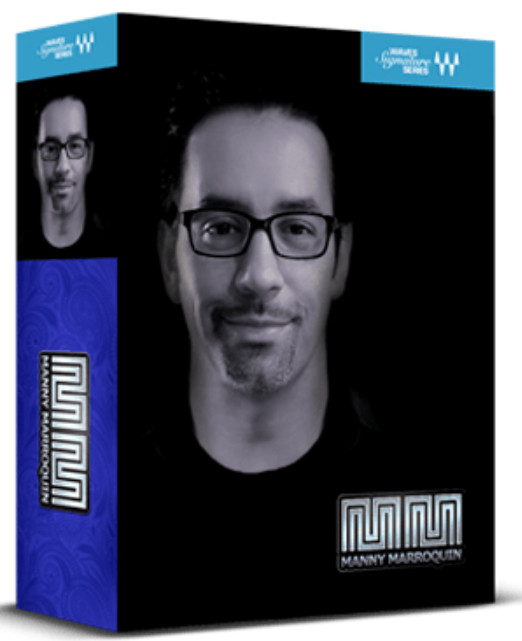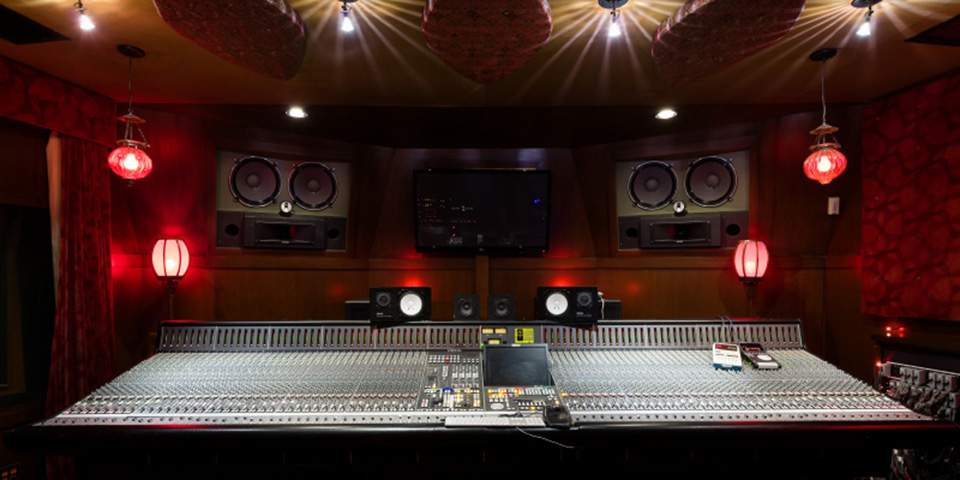News Flash! Manny Marroquin Mixes on Headphones
Want to get inside Manny Marroquin’s head?
It’s an enviable place. The 11-time Grammy Award winning mixer has worked on more than 250 albums, 40 #1 albums, one hundred Billboard Top 10 albums, and 40+ Top 10 singles. His client list includes Kendrick Lamar, Kanye West, Megan Thee Stallion, Post Malone, Lizzo, FKA Twigs, Alicia Keys, Bruno Mars, Imagine Dragons, and The Rolling Stones to name just a fraction.
Listening to those finished tracks is one way to teleport yourself into Marroquin’s inimitable ears. But now there’s another way, courtesy of the newly debuted Manny Marroquin Signature series headphones from Audeze. The line launches with the MM-500 (available in August), which makes the most of Audeze’s core audio technology and Marroquin’s extensive experience to create a high-performing, durable headphone made specifically for mixing.
The MM-500 delivers extreme clarity, very low distortion, and high efficiency via technology like Audeze’s 90MM planar magnetic drivers, while a new chassis design provides comfort over long-haul sessions. Its low impedance and high sensitivity allow it to be driven from a console, interface or laptop. For mixers wondering how to mix in headphones, these aim to provide the solution.
The MM-500 is by no means a one-and-done for Marroquin: Launching his new line coincides with being named Head of Professional Products for Audeze (said in the manner of “Odyssey” BTW). Extending his pursuit of meaningful diversification, headphone design is just one of the ways that Marroquin’s confidence keeps growing stronger – in many realms beyond mixing.
Manny, it’s been about a decade since our last interview! How’ve you been?
A lot has happened in the last 10 years. I’m still mixing like crazy, like it’s going out of style. I have the studio, Larrabee, which keeps growing – now we’re up to seven rooms.
I’ve also opened a restaurant [Verse LA], which is a music venue/restaurant next to Larrabee. In between, I’ve been working on headphones and releasing them. A lot of stuff happening!
That’s fantastic. And we both turned 50 recently, right?
Yeah, I just turned 50 six months ago! It feels good, man. 50 feels good.
I treated myself to a lot of Manny Marroquin mixes in the last few days. I loved Selena Gomez’ (2019 single) “Look at Her Now,” for one.
That song is crazy.
You went to town on that. That is a great song and it’s addictive, but it sounds like they also let you do whatever you wanted.
I remember while I was working on it, thinking, “Fuck, this is so good.” It’s a fresh production. She sounds great. It’s very punchy. It’s really musical. It fills the full frequency spectrum. It’s one of those rare songs that you get everything.
What’s a recent mix that you’re excited about?
I got to say I’m coming fresh off Kendrick Lamar’s Mr. Morale & the Big Steppers album. If you were to ask me, “What’s one of your favorite album collections of songs?” I would have to say that’s probably in the top three of all time.
It’s art. I can see how he’ll be doing this on Broadway, because it’s a concept album. A lot of sonic palettes, which is what I enjoy. We just talked about Selena going from the full spectrum and punchy, to a body of work where some songs are a little darker. And it’s obviously all very on purpose and very precise on the sonic landscape of the whole project, which we sometimes don’t discuss enough.
Kendrick was really, really involved and let me do my thing, too, which was really refreshing.
What else is floating your boat?
I’m having a fun mixing year so far. I started with Pusha T’s It’s Almost Dry, which is one of the great hip hop albums. Sonically it’s just punchy. Pharrell produced half of it and Kanye West produced the other half. I worked on the majority of it.
Probably the most underrated album so far is the Camila Cabello album Familia. There’s also Post Malone, Lizzo, Phoenix, The 1975, Paramore. I’m having such a great time.
See? When you hit 50, you’re getting better.
Man, it’s the confidence level. Right? I feel like when you do turn 50, your confidence level gives you a lot of freedom. You know you’ve got the wisdom, you’ve got the energy, and now you’ve got this freedom. That’s a scary combination.
Headphone Design: A New Adventure in Audio
How did you start working with Audeze on the MM-500 Manny Marroquin Signature Headphone?
When I first discovered Auedeze, about five years ago, [Audeze’s] Mark Cohen comes into my room and said, “Hey man, I got these headphones and you just got to listen to them!” Then you fast forward a few years and we kind of started talking about doing my own line based on technology that they had.
I wanted to design them not only aesthetically, but with a slightly different EQ curve that was better for the way I hear things. They took the time and we experimented. There’s no DSPs [digital signal processors] on the headphones, so any tweak was like, “We need to tweak the ear pad design slightly to get the frequency response just right,” or things like that. I learned so much about the art of EQ and headphones in the process.
Then I went to a wedding last year in The Bahamas. I was finishing mixing an album and I took my computer and the MM-500 prototype headphones in my hotel room. I ended up mixing pretty much the whole thing on the laptop in my hotel room with my headphones.
Then when I got back to LA, I played it in my room and the mix is exactly what I would’ve done in my room. At that point I told Audeze, “This is it. They’re done.”
Our design process was a couple years of us just going back and forth, making very subtle differences. But then, as you know, you do enough subtle changes that it becomes a much bigger difference overall.
Studio Monitors to Go
How would you characterize the way headphones fit into your workflow?
It was about having an extra set of monitors that I could take with me at all times. I’m so blessed to be at Larrabee, having access to some of the best sounding rooms and monitor equipment.
People ask me, “Why would you need headphones?” Well, nowadays we’re all on the go. I’ve got a studio on wheels. When we get a little older, we realize we want more experiences in the world – that means that you’ve physically got to be out in the world.
I love the art of mixing. I can’t just walk away and not do something for two weeks, even if I’m on vacation. For me it was like, “How can I be in France, in an Airbnb or a hotel and be able to make decisions that I’m confident with?” That was the big thing: How can I have an extra set of monitors that I can travel with?
What are additional benefits you experience with headphone mixing, beyond going mobile?
The other thing with headphones is that you can have the best monitoring in your room, but the width – it’s the hardest thing to do. Some of the delay trails and reverb trails, you’ve almost got to put headphones on to be able to really tell what that is. It’s very difficult to hear some of those things otherwise.
So there’s this dual purpose. Not only do I have an extra set of speakers I can travel with, but now I can reference some of the things in my room as I’m creating. That’s invaluable.
There’s a stigma among many mixers that it’s not okay to mix in headphones. Does your work with the Audeze MM-500 mean that it is? When is headphone mixing okay, and when is it not okay?
I try not to think about what other people think. Everyone’s always going to have an opinion, especially in our audio community there’s very strong opinions about everything.
What I try to do is simplify it. I always say, in a very selfish way, “What’s going to help me get from A to B in the most creative, best possible, quickest way without jeopardizing the quality? That’s how I think about it. So when it comes to mixing in headphones are not, I don’t believe in rules. There are no rules. There should not be any rules.
I take it a result of there being this “rule” against mixing in headphones is that maybe it’s hard to find a pair that can work as a pair of studio monitors. What that one of the driving principles behind the MM-500?
You’re a thousand percent correct. People send me all kinds of headphones, but I think they’re created for you to be able to enjoy music. I wanted to create something as a tool to be able to create.
I can’t say these are for you to listen and enjoy music, because there’s much better headphones for that. The MM-500 is something you can beat up, EQ, experiment, solo. You can color with them, in a way that I don’t know of any other headphone that I would have the confidence to do that with.
I think that’s the biggest difference between past headphones and this new MM-500. I’ve got to give Audeze a lot of credit for embracing the creators.
Creating with Confidence
Manny, the basics on the MM-500 is that it’s a studio headphone with low impedance and high sensitivity, but I haven’t gotten to experience them myself yet. Can you take it from there – how would you describe the MM-500 to another mixer?
It’s very transparent. In pop music today everything has an 808, a bass, a kick and sometimes many kicks. That’s the hardest area to really nail down (in headphones). The best way to describe the MM-500 headphones is the definition on the low end: You can actually hear and you can actually EQ.
When you go to your own room where you’re used to listening or working, or a car or wherever, it will translate exactly how you made it sound into that system. I haven’t been able to come across another headphone that would be that accurate.
Another hard thing is to make sure that those vocals shine, whatever type of song it is – that the mids are clean. Again, the MM-500 translates really well to the world.
I feel like monitors are as good as how well you know them. Right? I’m mixing on freakin’ NS-10’s, so I feel like these headphones will take you less time to really get to know and learn them. It’s a nice segue to just be able to have something that you’ll be confident working on.
Confidence is everything, and you know that when you’re wearing your headphones and you do any EQing, that you feel confident about it. The moment you use them a few times and you listen to it back in your system, you’re like, “Wow, that translated really well.”
I see that the MSRP is $1,699. For some people that’s a sizeable investment for headphones. What would you say you get when the price starts to go up?
The way I see it is that if it’s an essential tool for your business, then to me it’s a small price. I mean, if you want a really good set of speakers, you’re going to go spend the money on it. Your Pro Tools and your laptop is essential. You need that, right? You need a pair of monitors. At some point you’re going to need a good set of headphones. You’re just going to have to make that commitment and that investment. It’s that simple.
Now, do you need to go buy a hundred plugins? Imagine spending $250 on this plugin, $100 on this one, $500 on that one. Next thing you know, five plugins later, you’ve spent a couple grand and I guarantee you that those are not essential tools for your studio. There’s not one plugin that I can say will make or break my mix – I can always find an alternative to that. It doesn’t become as essential. But I see (the MM-500) as an essential tool for years to come.
Never Settle
Speaking of plugins, that leads right into my next question, which is, you’ve designed a series of plugins for Waves. How did that experience inform your collaboration on headphones? How are the design processes for plugins and headphones alike and how are they different?
What I learned from doing my plugins with Waves was that I cannot settle for something that I don’t believe in, number one. I love Waves as a company, but I think I might have quit like three or four times because they wanted me to do something slightly different.
I stuck to my gut, and I said, “No, this is what I want. This is what I feel should be, and if you can’t give me that, then there’s no point on us really continuing.” I was very transparent, very, very forward with that. I’ve got to give them props, too, for going on that journey with me. Those plugins took a long, long time.
One thing that I learned from that is you can’t put a time on something that you believe in. It could take you a year, five years. It doesn’t matter. Going into the headphones, I learned that it was going to take me a minute, and I was okay with that. Because the experience I had with Waves led me to what I think are good plugins that I still use every day, on every single one of my mixes.
From that, creatively I learned not to settle for anything. On the business side of things I learned to do something that you’re proud of. Ultimately, I’m the final user – follow your gut, and hopefully you have a product that other people will gravitate towards. That’s all we can ask for.
Maxing Manny
How has the process of designing the MM-500 headphones made you a better mixer?
It’s funny because I never thought about the design side of things, but if you were to break it down, the design was probably the most fun I’ve had because I had a huge input. Like, “Check out this color scheme and these different fonts!”
I always say, when you’re a mixer, producer, you’ve got to have enough left brain thinking and enough right brain thinking. You can’t have 100% right or 100% left. I mean, you can, but chances are, it’s going to be really hard to be successful at anything, because I feel like you have to have a good balance of creative right brain and the technical left brain. Helping out with the design gave me a little bit more confidence to keep being creative.
One thing that we forget in the studio is that we’re there to make the record better. What does that mean? If we take it even a step further, what does making a record better even mean? That’s the art, right? How do we perceive something to be better?
I personally go with emotion and my gut and all those things that people talk about. For me having fun with this creative process, it just gave me a little more bit more confidence in going into the studio and being, “Oh hell yeah! I feel good!”
It’s all about confidence. You can tell an insecure mix, you can hear it a mile away. You can hear a very confident mixer too – not a cocky mixer, but a confident mixer.
Destination: Diversification
Manny, this has been an awesome conversation! Here’s my last question: Why do you think all audio pros should take – or make – the opportunity to design gear and/or plugins?
I feel like we, as a community, are pigeonholed. They picked something for us, label us. And for me it’s like, “Oh, Manny the mixer. Manny, the studio rat and all he does is mix records.” I’ve been very conscious of that since I was super young.
Yes, that’s what I do for a living and that’s what I love, but I’m not just a mixer only. I’m an entrepreneur. I’ve got a studio, I’ve got a restaurant, I dabble in real estate. I’ve got other things outside of mixing. Mixing doesn’t define me.
I always encourage the younger generation to think outside the box. Just because somebody says you’re “that” don’t put yourself in that box. Get out of it, do something that drives you, come up with something that will make your workflow better. It could be anything, but not only in the studio or in your main job or whatever that is – just in general. If you believe in it, you’ve got to do it.
My thing with Audeze was not about creating a headphone. It was the last thing on my mind. It was about creating a tool that will make my workflow a lot easier, simpler and more effective, and it just happens to be a headphone. If all the younger engineer/producers/mixers can come up with something that will help their workflow, that’s why we’re here and it’s part of the evolution of our industry. This just happens to be a headphone.
And that circles back to the wisdom that you were talking about before.
Yes, that’s the wisdom, where I don’t know if I would’ve thought like this even 10 years ago. Hopefully anything that I do is just to make my workflow better – not necessarily to make money or to bring more attention to myself.
All that stuff doesn’t matter. What matters is: “Does it help me in the studio, with being creative and my workflow?” That’s the foundation.
— David Weiss is an Editor for SonicScoop.com, and has been covering pro audio developments for over 20 years. He is also the co-author of the music industry’s leading textbook on synch licensing, “Music Supervision, 2nd Edition: The Complete Guide to Selecting Music for Movies, TV, Games & New Media.” Email: david@sonicscoop.com
Please note: When you buy products through links on this page, we may earn an affiliate commission.










